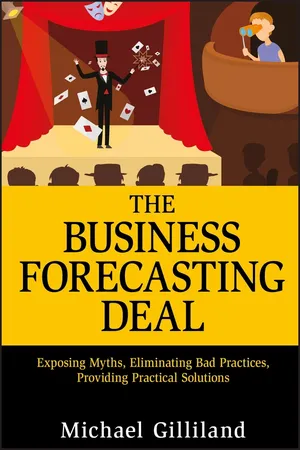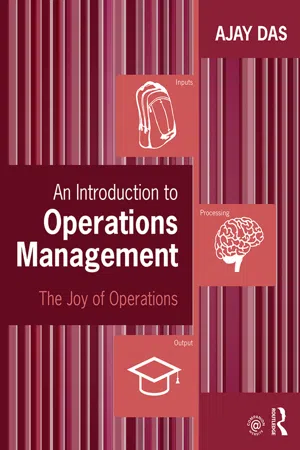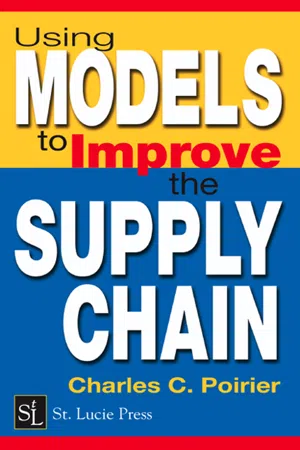Demand Forecasting
Demand forecasting is the process of estimating future customer demand for a product or service. It involves analyzing historical data, market trends, and other relevant factors to predict future demand levels. Accurate demand forecasting is crucial for businesses to optimize inventory levels, production schedules, and resource allocation, ultimately leading to improved operational efficiency and customer satisfaction.
8 Key excerpts on "Demand Forecasting"
- eBook - ePub
Operations Management for Business Excellence
Building Sustainable Supply Chains
- David Gardiner, Hendrik Reefke(Authors)
- 2019(Publication Date)
- Routledge(Publisher)
...Operations and supply chain management personnel use forecasts to make decisions about process selection, capacity planning, facility layout, production planning, scheduling, and inventory. A perfect forecast is a practical impossibility and the way to live with forecast inaccuracy is to have flexible production and delivery systems. An effective forecasting process allows the organisation to plan for all eventualities, to assess the likelihood of meeting the forecast values, and to evaluate the risk to the organisation of not meeting them. Forecasting is essential in operations and supply chain management. The purpose of Demand Forecasting is to determine the level of future spending. It costs money to buy capacity, to occupy a facility, to buy raw materials and components, to train and educate employees, and to deliver products and services to customers. Knowing the exact nature of future customer requirements allows us to supply that need comfortably. However, we very rarely know exactly what the customer wants and we try to compensate for that by second-guessing. This dilemma disappears somewhat when we change the supply pattern such that we are always able to supply with enough quantities within the customer tolerance time. With this scenario, the emphasis changes from predicting the future to supplying the need. The actual sales amount obtained for any product or service is the result of a combination of factors, including market share, actions by the organisation itself, actions by competitors, actions by suppliers and distributors, and actions by government agencies, to name a few. The supply function determines demand satisfaction and the resulting sales are a direct result of the ability to supply. Demand management Demand Demand is a need for a product or service. At the finished goods level demand may not equate to sales...
- eBook - ePub
- Tony Wild(Author)
- 2017(Publication Date)
- Routledge(Publisher)
...Where there is reliable historical information, this usually gives good forecasts, but future sales may not be reflected by history, so market information has to be used to identify potential changes in demand pattern. Unfortunately, this information is not so reliable. Clarifying the demand types will assist in forecasting. An analysis is: Continuing demand : Future demand continues from historical demand, so historical data is excellent for forecasting, even when demand is seasonal. Scheduled requirements : Customers provide extended forward demand rate information, so the need for stockholding is minimised and treated as ‘dependent demand’ (see Chapter 14). Changes in conditions : Marketing input is necessary where future demand levels will change significantly (through gain or loss of significant customers or markets). The forecast is again based on historical data. Events : Service for one-off demands are completely dependent on estimates from marketing experts. These can take the form of: product promotions and offers; focused advertising or sales campaigns; large single customer orders (where the demand is more than four MADs above the average); replenishment resulting from product recall or modification. Detailed analysis of demand, both historical and anticipated, provides better forecasts. The better the understanding of demand, the more accurate the forecast, and the more sophisticated the forecasting tool used to support this. Forecasting techniques can be analysed in many ways. One simple classification is between forecasts which use prediction and those which use history, another is between qualitative and quantitative figures, and another between intrinsic forecasting and extrinsic forecasting. Considering these concepts in turn, historical forecasts rely on looking back to predict the future. This is accurate as long as there is continuity or gradual change...
- eBook - ePub
- Jayanta Kumar Bandyopadhyay(Author)
- 2015(Publication Date)
- CRC Press(Publisher)
...Forecasting the demand of products or services is essential to the planning process of a modern business enterprise. Before making plans, a forecast must be made of demand that will exist over the future planning horizon. Many factors influence the demand for a firm’s products and services. While it is not possible to identify all of them, and their effect on demand, it is helpful to consider some of the major factors, such as general business and economic conditions, the passage of new government regulations, technological innovation, product obsolescence, competitive factors, market trends, and the company’s own plans for advertising, promotion, pricing, and product design changes. Forecasts must be made for the business plan, the production plan, and the master production schedule. The purpose, planning horizons, and level of detail vary for each case as follows: The business plan is concerned with overall markets and the direction of the economy over the next 3–10 years or more. Its purpose is to provide time to plan for those things that take a long time to change. For a manufacturing business organization, the business plan should provide sufficient time for resource planning: plant expansion, capital equipment purchase, and those things that require a long lead time to purchase. The level of detail is not high, and usually forecasts are in sales units or sales dollars. The forecast and the plan will probably be reviewed yearly. The production plan is concerned with manufacturing activity for the next 1–3 years. For manufacturing, it means forecasting those items needed for production planning, budgeting, manpower planning, material requirement and procurement planning, and managing overall inventory levels. Forecasts are made for groups or families of products rather than specific end items. Forecasts and production plans are reviewed monthly. The master production schedule is concerned with production activity from the present time to a few months ahead...
- eBook - ePub
The Business Forecasting Deal
Exposing Myths, Eliminating Bad Practices, Providing Practical Solutions
- Michael Gilliland(Author)
- 2010(Publication Date)
- Wiley(Publisher)
...The danger is that if you do not know what accuracy is reasonable to expect, you can reward inferior performance, or you can waste resources pursuing unrealistic or impossible accuracy objectives. You can also miss opportunities for alternative (non-forecasting) solutions to your business problems. WHAT IS DEMAND? This book is about forecasting for products and services. It is not about forecasting the weather, or interest rates, or the outcome of sporting or political events. It is about forecasting the quantity of things people will buy or the quantity of services they will seek. In business forecasting, we talk about demand every day. We don’t think much about our use of the word because it seems pretty straightforward. Demand is commonly characterized as, “what the customers want, and when they want it,” sometimes with the added proviso, “at a price they are willing to pay, along with any other products they want at that time.” So far, everything seems to make sense. When we refer to demand, we usually mean unconstrained or true demand because we take no consideration of our ability to fulfill it. (Note: I will treat demand, unconstrained demand, and true demand as synonyms.) We use constrained demand to describe how much of true demand can be fulfilled (after incorporating any limitations on our ability to provide the product or service demanded). Thus, constrained demand ≤ demand. A good forecast of demand, far enough into the future, allows an organization to invest in all and only the facilities, equipment, materials, and staffing that it needs to most profitably fulfill that demand. The value of a good demand forecast is readily apparent, and we valiantly load demand history into our software and statistical models to start the forecasting process. The common characterization of demand becomes problematic, however, once we try to operationalize it (that is, when we start to describe the specific, systematic way to measure it)...
- eBook - ePub
An Introduction to Operations Management
The Joy of Operations
- Ajay Das(Author)
- 2015(Publication Date)
- Routledge(Publisher)
...Recognize that surprises wait around the next corner—supply chain and logistics glitches, disasters, quality issues, labor problems, competition actions, and market changes can disrupt the best of forecasts. Realistically, we seek to improve consistently rather than pursue unattainable 100 percent accuracy. A process that monitors mistakes and identifies and tries to correct/learn from reasons for major mistakes is essential. We should be honest and quick about communicating forecast errors to the entire organization and its supply chain so that suitable risk management strategies such as hedging, buffering, and risk-pooling can be developed and applied. Even though business forecasting is an uncertain endeavor, forecasting has utility. It reduces the set of options for decision making and offers guidance using history, experience, and knowledge as markers. Done well, it can reduce uncertainty and stimulate preemptive actions. What Have We Learned? What Is Forecasting? Business forecasting uses human experience, human responses, human judgment, and historical data to develop a probabilistic statement about future events and trends. A forecast states the future value of a particular variable(s) of business interest. Why Is It Important? Demand forecasts are used for marketing and operational decisions and drive other forecasts, interest rate forecasts are used in financing decisions, inflation forecasts are used for labor and supply contracts, and commodity price forecasts are used in purchasing decisions. Offers the opportunity to act proactively...
- eBook - ePub
- Charles C. Poirier(Author)
- 2003(Publication Date)
- CRC Press(Publisher)
...That means the forecast is based on consumer units, cases, equivalent cases, retail sales dollars, wholesale dollars, cost dollars, pounds, or some form of standardized sales currency. FORECASTING IS A CIRCULAR PROCESS An important realization in the development of improved forecasting is that it is a circular process. That is, the firm plays a proactive role in creating self-fulfilling prophecies. If forecasts based on the best available analysis fail to meet financial objectives, then product plans, advertising, and marketing programs can be instituted that have a proactive effect on future demand. In Figure 5.5, showing a forecast creation process, it can be seen that any such process begins with whatever information is available to the system—orders, point-of-sale data, and shipments, for example. From there, a demand history is maintained on a perpetual basis. Some scrubbing or adjustment can be performed based on market and customer intelligence. A variety of statistical forecasting tools are available in this area, from simple averaging smoothing methods and regression analysis, to Pareto analysis, frequency analysis, and econometric models. Figure 5.5 Forecast Creation—A Circular Process The point to bear in mind is that forecasting should involve analyzing data and selecting tools that effectively improve accuracy at a reasonable cost. A fundamental element of any good forecast is the ability to apply business intelligence and manage uncertainty through effective use of the available information. The flow around the chart is impacted by a total organizational effort, including the need to meet financial expectations. Figure 5.6 describes how the forecasting system for the manufacturer-retailer mentioned supports decisions across time and the various operations between the purchase of ingredients and sales to customers. A firm needs to determine the detail necessary for its processing and a similar chart developed...
- eBook - ePub
On Time, In Full
Achieving Perfect Delivery with Lean Thinking in Purchasing, Supply Chain, and Production Planning
- Timothy McLean(Author)
- 2017(Publication Date)
- Productivity Press(Publisher)
...However, as I said above, the forecast is only an estimate of what might happen, and a rough estimate at that, so trying to finesse the data is fairly pointless. A difficult issue can be new product development. You know the product is coming, but you don’t know how well it will sell or perhaps even what it will be called. In this case, you may choose to insert a line in your forecast for the new product demand so that you lock in the production capacity, but do not necessarily trigger ordering of materials. By maintaining a monthly update, you will soon start to learn what changes need to be specifically incorporated into the forecast and which ones are not significant. You will also find the most meaningful level to forecast at. In Chapter 4, we will explain sales and operations planning, a structured approach to reviewing your business’s demand, and its ability to supply over a 12- to 18-month time horizon. Key Points in Chapter 3 Traditional push approaches to supply chain management are based on using a forecast to determine future requirements for products and materials in order to meet future customer demand. This model suffers because forecasts are inherently inaccurate, because humans cannot predict the future. The accuracy of a forecast is impacted by three parameters: – The length of the forecast: The further you try to forecast into the future, the less accurate the forecast will be. – The time interval being forecasted: Forecasting a larger time interval will give a more accurate result than a shorter time interval. Therefore, it is much easier to forecast monthly demand than weekly or daily demand. – The level of the forecast: Accurately forecasting demand for every individual product is much harder than forecasting product families or value streams. Taking into account these factors, the most useful forecast is a simple monthly forecast of demand for the whole value stream extended out for 12 months...
- eBook - ePub
Flying Off Course
Airline Economics and Marketing
- Rigas Doganis(Author)
- 2019(Publication Date)
- Routledge(Publisher)
...Yet forecasts have to be made since so many decisions flow from them. The annual budgets and the longer-term plans on which so many supply decisions hinge start with forecasts of passenger and freight traffic. Forecasting involves different types of forecasts, each of which pose different methodological problems. In the first instance, airlines need to forecast traffic growth assuming a continuation of current operating conditions with no dramatic changes in fares or in other supply factors. They may forecast the total growth of passenger and/or freight traffic on a route, group of routes or geographical region. Such forecasts represent the total demand, from which the airline then has to predict its own share and its own traffic. Essentially, they involve an assumption that, all other things being equal, traffic growth will continue in the future very much as it has done in the past. But frequently ‘all other things’ are not equal. They do not remain unchanged. The economic climate, exchange rates, and changing tourism trends are among the many external factors that impact on demand and may change over time or very quickly, as is the case after terrorist attacks. Many external factors that impact directly on the demand for air travel or air freight are unforeseeable. Their impact may be local or much wider. Because external factors are unpredictable they create much of the uncertainty in airline forecasting. Demand is also dependent on numerous internal factors and changes. Airlines need to be able to forecast the response of demand to a change in the conditions of supply. Such changes may include an increase or reduction in the real level of fares, a change from narrow- to wide-bodied aircraft, a marked increase in frequencies or a change in departure times. A significant change in supply conditions may be under consideration by the airline itself or change may be imposed by one or more of its competitors...







